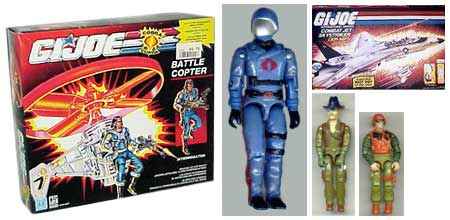G.I. Joe (80's, 90's)

Synopsis of Toy
“A Real American Hero”
War. What is it good for? Toys. Really cool toys.
G.I. Joe had already seen two decades of service by the early 1980’s, but the military action figure line got a new tour of duty with the dawn of the Reagan Years. Military toys had taken a bit of a beating in the wake of the Vietnam War, but in a new era of “America vs. The Evil Empire” patriotism, the time was right for Joe’s return.
G.I. Joe’s comeback began in 1982, but these weren’t your father’s Joes—they were about three times smaller. In place of the old fully-dressed 12-inch action figures, Hasbro’s new Joes were 3¾ inches of compact plastic power. And while the little guys may have lacked realistic human hair and a kung-fu grip, they had a few tricks up the sleeves of their military fatigues.
The first smart move on Hasbro’s part was setting up a Cold-War-esque conflict between “Real American Heroes” (G.I. Joe) and a faceless, purely evil enemy (Cobra). The toys naturally favored the Joe side—initially nine Joes (Grunt, Short-Fuze, Flash, Zap, Breaker, Stalker, Rock and Roll, and long-term favorites counter-intelligence operative Scarlett and ninja commando Snake Eyes) to two Cobras (a Cobra foot soldier and Cobra Officer)—but as G.I. Joe’s renewed popularity grew, new figures joined the fight on each side.
The second brilliant field maneuver in the G.I. Joe comeback was a tie-in with Marvel Comics, who tapped writer Larry Hama to create a G.I. Joe comic book series that also began in 1982. Hama gave the toy line a touch of military authenticity (he also wrote most of the character “File Cards” on the back of the toy packages), and the companies cross-promoted their products in a long-running series of animated and live-action TV commercials. The idea was simple—watch the thrilling animated battle, whet your appetite to see what happens next in the comic, then re-imagine the battles with figures and vehicles of your own. Simple, and overwhelmingly successful.
New Joes, Cobras and assorted accessories appeared every year, creating an arms race on both sides of the conflict. The Joes got tattooed Marine Gung-Ho, SEAL officer Torpedo, First Sergeant (and later field commander) Duke, K-9 officer Mutt and dog Junkyard, heavy gunner Roadblock, warrant officer Flint (he of the black beret), covert operative Lady Jaye, and a whole platoon’s worth of other specialists. Cobra matched their rivals’ growing army with the masked Cobra Commander, steel-faced Destro, eyepatch-wearing Major Bludd, the Baroness, saboteur Firefly, ninja Storm Shadow, “Evil Master of Disguise” Zartan (who actually changed colors in sunlight), twins Tomax and Xamot, and a host of faceless soldiers like the Crimson Guard.
On the vehicle front, the two sides faced off in “some assembly required” battlewagons like the battery-powered MOBAT Tank, the H.I.S.S. Tank, the Dragonfly Copter, the Falcon and Viper Gliders (which actually glided with figures inside), Flight Pods, the Bridge Layer, the Sharc flying submarine, and the ever-popular dueling jets the Combat Jet Skystriker and the Cobra Rattler, among many others. And for the true G.I. Joe fan with a bit more money to spare, Hasbro produced vehicle/playsets like the G.I. Joe Headquarters, the U.S.S. Flagg Aircraft Carrier, the Cobra Terrordrome and the G.I. Joe Defiant Space Shuttle Complex. The TV commercials summed up the experience of owning one of these mammoth playsets: Kid #1 – “I got it!” Kid #2 – “Wow!”
The Hasbro/Marvel alliance also paid off handsomely with an action-packed G.I. Joe animated series, produced by Marvel and Sunbow. The Joe machine now fed itself on the cartoon, comic and toy fronts, wildly successful on each. G.I. Joe was no longer just a 60’s toy looking for a return to glory—it was an American Hero back on the front lines and bigger than ever.
But like all good military men, G.I. Joe faced a common dilemma: What’s an old soldier to do when all the good battles have been fought? To keep the Joe line fresh, Hasbro created new promotions regularly—1985 brought real-life pro wrestler Sgt. Slaughter to the Joe team, 1986 added Chicago Bears football star William “The Refrigerator” Perry, 1987 brought the transforming Battleforce 2000 vehicles, etc.—but kids’ tastes were once again turning. The G.I. Joe animated series left the air in 1987 after a direct-to-video movie, but the toys soldiered on.
A second, DIC-produced series of cartoons debuted in 1989, and Hasbro tried to draw in new and old Joe fans with Micro Figures, Command Rings, bright neon paintjobs, and other strategies. But the fact remained that the “Evil Empire” had fallen with the collapse of the Berlin Wall, and military action figures were once more giving way to other toys. Hasbro created a new Drug Elimination Force to give Joe another enemy, but it was all in vain. In 1994, the 3¾” G.I. Joe line was taken off active duty and sent into retirement.
Real American Heroes aren’t so easily defeated, however. G.I. Joe had returned to his roots in 1992 as a 12-inch “Hall of Fame Collection,” and the taller, clothed, fully-poseable toys caught back on in a big way with old-school Joe fans and their younger counterparts. After a less-than-successful stint as G.I. Joe Extreme, the 3¾” Joes made a comeback of their own in 1997 with a new line of faces old and new. Joes both big and small continue to be produced today, bringing steely grins to the faces of collectors and of kids who just like a touch of war in their toys.
Release History of Toy
1964 - G.I. Joe (12")1982 - G.I. Joe (3 3/4")
